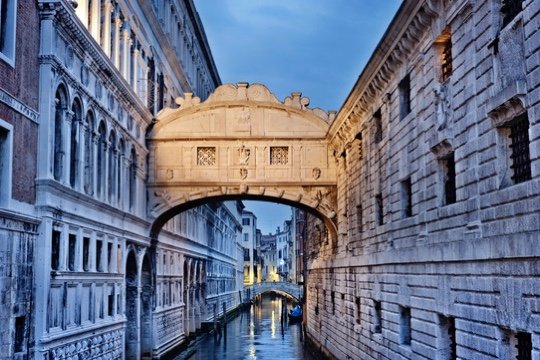
Palladio’s influence on Thomas Jefferson and Classical American Architecture
So, what is it about Andrea Palladio, a 16th century architect, that would inspire us to name our tour service after him? Why do we feature his works so prominently in our tours? And probably the most important question - what relevance does his work have to any of us in 21st Century America? The answer is both simple and profound.

Saint Mark and Venice: More Than Meets the Eye
The striking Saint Mark’s Basilica is not only one of the absolute masterpieces of Byzantine sacred architecture, but it is also the final resting place of the Evangelist’s body. Few, however, are aware of the adventurous history that brought the famous relic there.

The Enchanting Beauty of Padua and Its Scrovegni Chapel
When most people consider the treasures of Veneto, the innumerable wonders of Venice come instantly to mind. To the well-traveled voyager, if asked what the single most spectacular monument to the region’s remarkable past is, I’m wagering they would nominate Padua’s incomparable Scrovegni Chapel.

The City of Vicenza and the Palladian Villas of Veneto
Mid-way between Padua and Verona, and easily accessible, as a tourist attraction it is often overpowered by the better-known Venice, Verona and Padua. However, we at Palladio Tours consider it a jewel well worth exploring.

Antonio Canova, one of the leading sculptors in the history of Western art
Antonio Canova is considered the most important sculptor of the late eighteenth century. After the artistic excesses of the Baroque period, Canova proposed a return to a clear and simple classical form of sculpture inspired by Roman art.
It is enough to look at Eurydice and Orpheus, at the Museo Correr, Venice, that Canova completed when he was only twenty years old, to understand the basics of Canova’s aesthetic principles.

Palladio’s villas - Architectural Inspirations from His Century to Our Own
Few architects have been as influential as Andrea Palladio (1508 -1580) one of the undisputed geniuses of the Italian Renaissance, whose creations are all concentrated in a relatively small territory of the Veneto region.

The Dungeons of the Doge - Open to the Public and a Landmark Not to Be Missed
The traveler who in Venice admires the magnificent façade of the Doge’s Palace and its eclectic mishmash of Western and Eastern styles is usually unaware that inside this very building, just a few steps away from its stunning gold-gilded halls there is the most dreaded facility of the Serenissima: its prisons. Today they are open to the public and are landmark not to be missed.

Carnevale of Venice, the Most Flamboyant of all Pre-lenten Celebrations
The modern Carnevale of Venice, a celebration of costume, exhibition and sweet delicacies like nowhere else, dates from 1979. It is the 10-day spectacle of party and disguise prior to the Christian season of Lent. Resurrected from a long dormancy to promote tourism, it now entails throngs of people disguising their faces behind decorative masks while others dress in spectacular costumes.

Marostica: from Magnificent Cherries to a Human-sized Tournament of Chess
Outside the city’s walls, you will find the hills resplendent with cherry trees, the origins of some dating from the most ancient of pre-historic times of human societies. As you enter the town through the main door of the ancient walls, the first thing that strikes you is the human-sized chess board that is in the center of the main square.

The Ghetto of Venice, the Area in which the Jews Were Forced to Live for Centuries
While exiting the main train station, travelers might easily miss a small bridge leading to one of the most fascinating areas of the city. As soon as they cross the bridge, enter the narrow and dark corridor and emerge on the other side they will find themselves in the Jewish Ghetto of Venice, the Cannaregio area in which the Jews were forced to live for centuries.

Baccalà – Norwegian Cod, Prepared in a Delicious Venetian Style
Baccalà – Norwegian Cod, Prepared in a Delicious Venetian Style
This love affair with baccalà had its origins in the 15th century, thanks a Venetian seafaring merchant who set off from Crete in a ship loaded with wine, spices and cotton. His port of call was to be in Belgiumbut he was driven north by a severe Atlantic winter storm, shipwrecked and saw his riches vanish.
Only 11 of the crew survived the sinking but managed to reach the freezing island of Røst. There, they were cared for by the islanders who ate mainly codfish - fresh, salted or dried.

A visit from “La Befana”, a Legend Originating from the Journey of the Magi
During the night between the 5th and 6th of January, Italian children wait for the Befana. She is an old woman who leaves candy and toys for well-behaved children - and coal for the bad ones. Wise children make sure they leave an orange and a glass of wine for the good old lady!
In the Christian tradition, the story of the Befana is closely linked to that of the Magi - Balthazar, Gaspar, and Melchior. According to legend, on their long journey to Bethlehem to pay homage to Jesus and unable to find their way, they asked for information from an old woman who showed them the route.

Italians and their Kindness to Strangers
Years of travel - many good memories. One traveler’s experience with the kindness shown him by strangers

Carnevale in Castelfranco Veneto
A colorful annual celebration during the week prior to Lent

Bigoli in Alici Sauce: an Original Recipe with a History
Imagine you are entering a Venetian kitchen, you hear the onion frying, you smell the scent of fish; they are the sounds and scents of the most authentic tradition, representing a culture that often does not come from the wealthy classes, but from the customs of the lower classes. This is the "Bigoli in Alici (anchovies) sauce", a typical recipe from the Veneto region.
